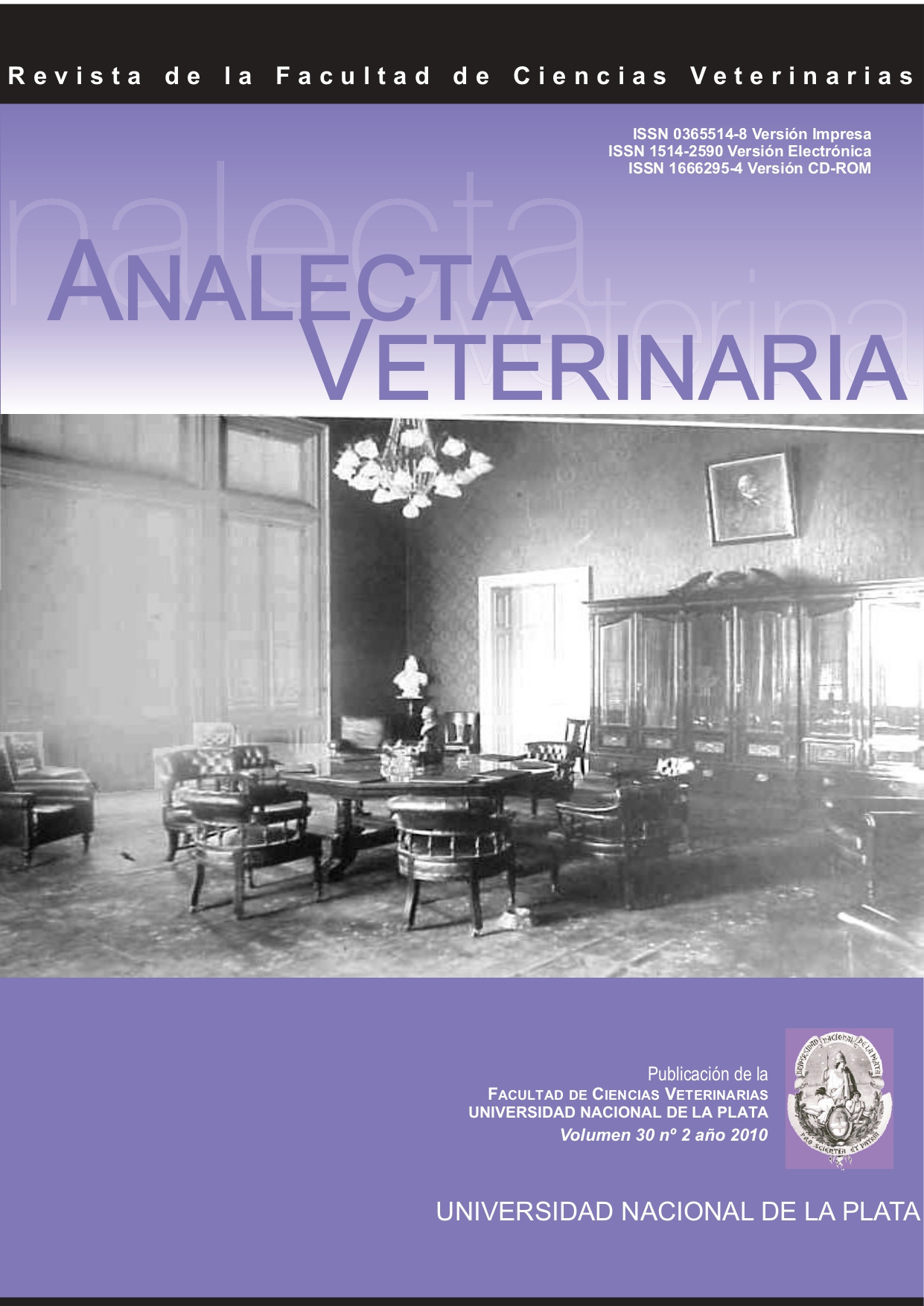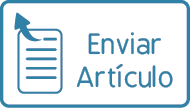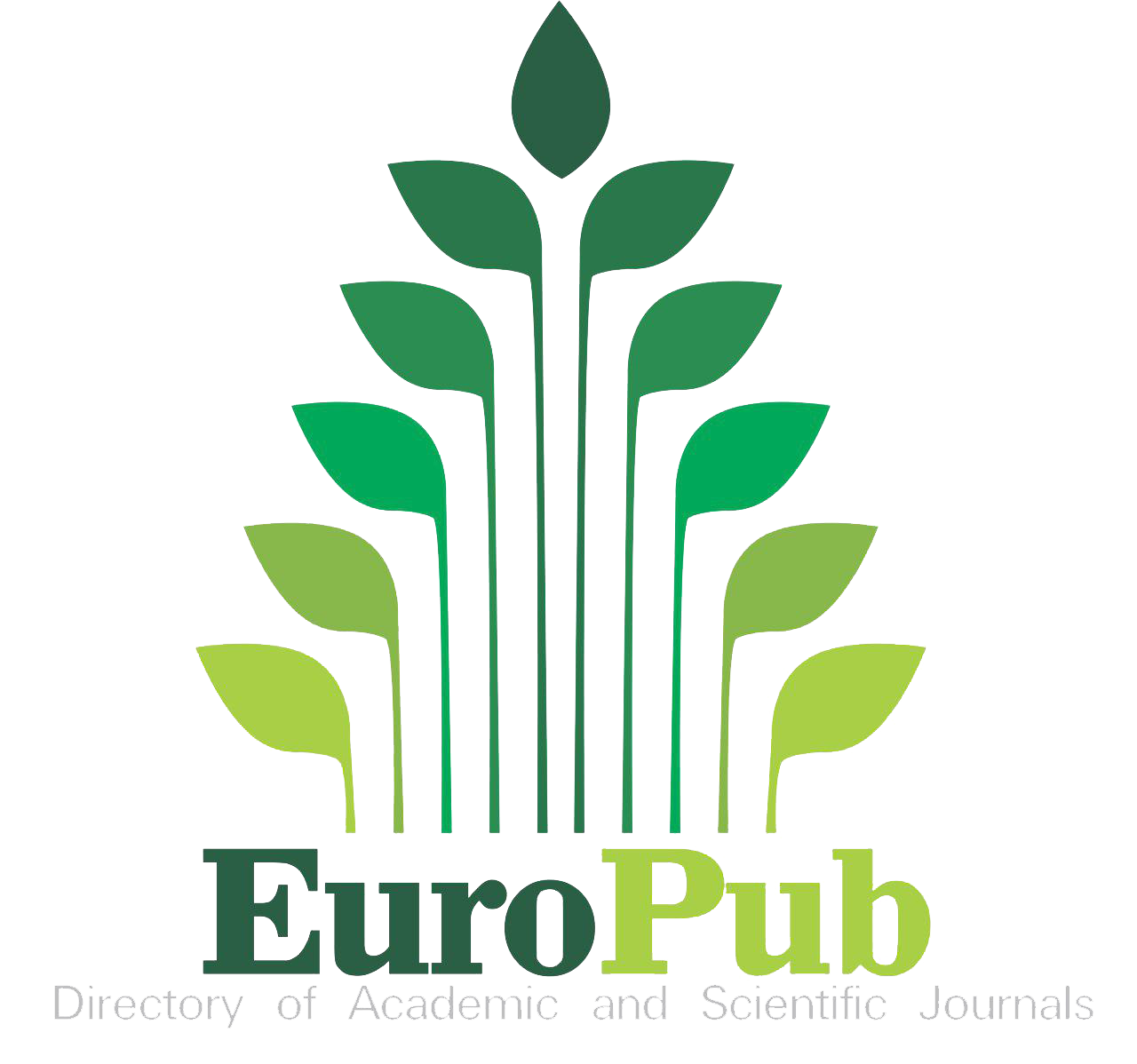E. coli Enterohemorrágica: factores de virulencia e infección en el ganado
Palabras clave:
EHEC, E. coli O157:H7, factores de virulencia, ganado bovino, colonizaciónResumen
Las cepas de E. coli enterohemorrágica (EHEC) constituyen un subgrupo de las E. coli verotoxigénicas (VTEC) o E. coli productoras de toxinas Shiga (Stx) (STEC). Dentro de este grupo, E. coli O157:H7 es el serotipo productor de Stx más conocido. Las cepas de EHEC producen colitis hemorrágica y el síndrome urémico hemolítico en humanos. Al igual que las cepas enteropatogénicas de E. coli (EPEC), estas cepas median su patogénesis a través de lesiones de "adherencia y destrucción" (lesión A/E). El ganado bovino es el principal reservorio de E. coli O157:H7 y se lo asocia directamente a la mayoría de los brotes en humanos. En esta revisión se analizan los factores de virulencia involucrados en la patogénesis de las cepas EHEC, especialmente aquellos que participan en la colonización de la mucosa intestinal de los bovinos.
Referencias
Besser TE, Hancock DD, Pritchett LC, McRae EM, Rice DH, Tarr PI. Duration of detection of fecal excretion of Escherichia coli O157:H7 in cattle. J Infect Dis. 1997; 175: 726-729.
Bretschneider G, Berberov EM, Moxley, RA. Re- duced intestinal colonization of adult beef cattle by Escherichia coli O157:H7 tir delition and Nalidixic- acid-resistant mutants lacking flagellar expression. Sixth International Symposium on Shiga Toxin (Verocytotoxin)–Producing Escherichia coli Infections., Melbourne, Australia, from Oct. 29th to Nov 1st , 2006; Abstract No. P09.1.04
Bretschneider G. Escherichia coli O157:H7 infection and associated immune responses in adult cattle. Ph.D Thesis. University of Nebraska, Lincoln, United States of America. 2007.
Bretschneider G, Berberov EM, Moxley RA. Re- duced intestinal colonization of adult beef cattle by Escherichia coli O157:H7 tir deletion and nalidixic- acid-resistant mutants lacking flagellar expression. Vet Microbiol. 2007a; 125:381- 386.
Bretschneider G, Berberov EM, Moxley RA. Isotype- specific antibody responses against Escherichia coli O157:H7 locus of enterocyte effacement proteins in adult beef cattle following experimental infection. Vet Immunol Immunopathol. 2007b; 118:229- 238.
Bretschneider G, Berberov EM, Moxley RA. Enteric mucosal antibodies to Escherichia coli O157:H7 in adult cattle. Vet Rec. 2008; 163:218-219.
Brown CA, Harmon BG, Zaho T, Doyle MP. Experi- mental Escherichia coli O157: H7 carriage in calves. Appl Env Microbiol. 1997; 63:27-32.
Caprioli A, Morabito S, Brugere H, Oswald E. En- terohaemorrhagic Escherichia coli: emerging issues on virulence and modes of transmission. Vet Res. 2005; 36:289-311.
Chen HD, Frankel G. Enteropathogenic Escherichia coli: unravelling pathogenesis. FEMS Microbiol Rev. 2005; 29:83-98.
Clarke SC, Haigh RD, Freestone PP, Williams PH. Virulence of enteropathogenic Escherichia coli, a global pathogen. Clin Microbiol Rev. 2003; 16:365-378.
CNSAP (Comité de Nefrología de la Sociedad Ar- gentina de Pediatría), 2005. Boletín Nº 4.
Cray WC Jr, Moon HW. Experimental infection of calves and adult cattle with Escherichia coli O157:H7. Appl Environ Microbiol. 1995; 65:586-1590.
Dean-Nystrom EA, Bosworth BT, Moon WH O’Brien AD. Pathogenicity of Escherichia coli O157: H7 in the intestines of neonatal calves. Infect Immun. 1997; 65: 1842-1848.
Deng W, Li Y, Hardwidge PR, Frey EA, Pfuetzner RA, Lee S, Gruenheid S, Strynakda NC, Puente JL, Finlay BB. Regulation of type III secretion hierarchy of translo- cators and effectors in attaching and effacing bacterial pathogens. Infect Immun. 2005; 73:2135-2146.
DeVinney R, Gauthier A, Abe A, Finlay BB. Entero- pathogenic Escherichia coli: a pathogen that inserts its own receptor into host cells. Cell Mol Life Sci. 1999a; 55:961-976.
Fegan N, Vanderlinde P, Higgs H, Desmarchelier P. The prevalence and concentration of Escherichia coli O157 in faeces of cattle from different produc- tion systems at slaughter. J Appl Microbiol. 2004; 97:362-370.
Frankel G, Phillips AD, Trabulsi LR, Knutton S, Dougan G, Matthews S. Intimin and the host cell--is it bound to end in Tir(s)?. Trends Microbiol. 2001; 9:214-218.
Ghosh P. 2004. Process of protein transport by the type III secretion system. Microbiol Mol Biol Rev. 2004; 68:771-795.
Gibbs RJ, Stewart J, Poxton IR. The distribution of, and antibody response to, the core lipopolysaccharide region of Escherichia coli isolated from the faeces of healthy humans and cattle. J Med Microbiol. 2004; 53:959-964.
Girón JA, Torres AG, Freer E, Kaper JB. The flagella of enteropathogenic Escherichia coli mediate adherence to epithelial cells. Mol Microbiol. 2002; 44:361-379.
Haack KR, Robinson CL, Miller KJ, Fowlkes JW, Mellies JL. Interaction of Ler at the LEE5 (tir) operon of enteropathogenic Escherichia coli. Infect Immun. 2003; 71:384-392.
Hayashi F, Smith KD, Ozinsky A, Hawn TR, Yi EC, Goodlett DR, Eng JK, Akira S, Underhill DM, Aderem
A. The innate immune response to bacterial flagellin is mediated by Toll-like receptor 5. Nature. 2001; 410:1099-1103.
Hueck CJ. Type III protein secretion systems in bacterial pathogens of animals and plants. Microbiol Mol Biol Rev. 1998; 62:379-433.
Johnson,RP, Cray WC Jr, Johnson ST. Serum antibody responses of cattle following experimental infection with Escherichia coli O157:H7. Infect Immun. 1996; 64:1879-1883.
Kaper JB, Nataro JP, Mobley HL. Pathogenic Es- cherichia coli. Nat Rev Microbiol. 2004; 2:123-140.
Khaitsa ML, Smith DR, Stoner JA, Parkhurst AM, Hinkley S, Klopfenstein TJ, Moxley RA. Incidence, duration, and prevalence of Escherichia coli O157:H7 fecal shedding by feedlot cattle during the finishing period. J Food Prot. 2003; 66:1972-1977.
Koohmaraie M, Arthur TM, Bosilevac JM, Guerini M, Shackelford SD, Wheeler TL. Post-harvest inter- ventions to reduce/eliminate pathogens in beef. Meat Sci. 2005; 71:79-91.
Kudva IT, Hatfield PG, Hovde CJ. Effect of diet on the shedding of Escherichia coli O157:H7 in a sheep model. Appl Environ Microbiol. 1995; 61:1363-1370.
Levine MM. Escherichia coli that cause diarrhea: enterotoxigenic, enteropathogenic, enteroinvasive, enterohemorrhagic, and enteroadherent. J Infect Dis. 1987; 155:377-389.
Mahajan A, Currie CG, Mackie S, Tree J, McAteer S, McKendrick I, McNeilly TN, Roe A, La Ragione RM, Woodward MJ, Gally DL, Smith DG. An investigation of the expression and adhesin function of H7 flagella in the interaction of Escherichia coli O157: H7 with bovine intestinal epithelium. Cell Microbiol. 2009; 11:121-137.
Mecsas JJ, Strauss EJ. Molecular mechanisms of bacterial virulence: type III secretion and pathogenicity islands. Emerg Infect Dis. 1996; 2:270-288.
Naylor SW, Low JC, Besser TE, Mahajan A, Gunn GJ, Pearce MC, McKendrick IJ, Smith DG, Gally DL.. Lymphoid follicle-dense mucosa at the terminal rectum is the principal site of colonization of enterohemor- rhagic Escherichia coli O157:H7 in the bovine host. Infect Immun. 2003; 71:1505-1512.
Nougayrede JP, Fernandes PJ, Donnenberg MS. Adhesion of enteropathogenic Escherichia coli to host cells. Cell Microbiol. 2003; 5:359-372.
Noya O, De Noya BA, Ballen DE, Bermudez H, Bout D, Hoebeke J. Immunogenicity of synthetic peptides from the Sm31 antigen (cathepsin B) of the Schisto- soma mansoni adult worms. Parasite Immunol. 2001; 23:567-573.
Ogino T, Ohno R, Sekiya K, Kuwae A, Matsuzawa T, Nonaka T, Fukuda H, Imajoh-Ohmi S, Abe A. Assembly of the type III secretion apparatus of enteropathogenic Escherichia coli. J Bacteriol. 2006; 188:2801-2811.
Ottemann KM, Miller JF. Roles for motility in bacterial-host interactions. Mol Microbiol. 1997; 24:1109-1117.
Peterson RE, Klopfenstein TJ, Erickson GE, Folmer J, Hinkley S, Moxley RA, Smith DR. Effect of Lacto- bacillus acidophilus strain NP51 on Escherichia coli O157:H7 fecal shedding and finishing performance in beef feedlot cattle. J Food Prot. 2007a; 70:287-291.
Peterson RE, Klopfenstein TJ, Moxley RA, Erick- son GE, Hinkley S, Bretschneider G, Berberov EM, Rogan D, Smith DR. Effect of a vaccine product con- taining type III secreted proteins on the probability of Escherichia coli O157:H7 fecal shedding and mucosal colonization in feedlot cattle. J Food Prot. 2007b; 70: 2568- 2577.
Potter AA, Klashinski S, Li Y, Frey E, Townsend H, Rogan D, Erickson G, Hinkley S, Klopfestein T, Moxley RA, Smith DR, Finlay BB. Decreased shed- ding of Escherichia coli O157: H7 by cattle following vaccination with type III secreted proteins. Vaccine. 2004; 22:362-369.
Proulx F, Seidman EG, Karpman D. Pathogenesis of Shiga toxin-associated hemolytic uremic syndrome. Pediatr Res. 2001; 50:163-171.
Ramos HC, Rumbo M, Sirard JC. Bacterial flagel- responses in mucosa.Trends Microbiol. 2004; 12:509-
Renter DG, Sargeant JM. Enterohemorrhagic Escherichia coli O157: epidemiology and ecology in bovine production environments. Anim Health Res Rev. 2002; 3:83-94.
Ritchie JM, Waldor MK. The locus of enterocyte effacement-encoded effector proteins all promote enterohemorrhagic Escherichia coli pathogenicity in infant rabbits. Infect. Immun. 2005; 73:1466-1474.
Rodriguez-Escudero I, Hardwidge PR, Nombela C, Cid VJ, Finlay BB, Molina M. Enteropathogenic Escherichia coli type III effectors alter cytoskeletal function and signalling in Saccharomyces cerevisiae. Microbiology. 2005; 151:2933-2945.
Roe AJ, Hoey DE, Gally DL. Regulation, secretion and activity of type III-secreted proteins of enterohae- morrhagic Escherichia coli O157. Biochem Soc Trans. 2003; 31:98-103.
Sekiya K, Ohishi M, Ogino T, Tamano K, Sasakawa S, Abe A. Supermolecular structure of the enteropatho- genic Escherichia coli type III secretion system and its direct interaction with the EspA-sheath-like structure. Proc Natl Acad Sci USA. 2001; 98:11638-11643.
Sheng H, Lim JY, Knecht HJ, Li J, Hovde CJ. Role of Escherichia coli O157:H7 virulence factors in colo- nization at the bovine terminal rectal mucosa. Infect Immun. 2006b; 74:4685-4693.
Sircili MP, Walters M, Trabulsi LR, Sperandio V. Modulation of enteropathogenic Escherichia coli virulence by quorum sensing. Infect Immun. 2004; 72:2329-2337.
Smith DR, Blackford M, Younts S, Moxley R, Gray J, Hungerford L, Milton T, Klopfenstein T. Ecological relationships between the prevalence of cattle shed- ding Escherichia coli O157:H7 and characteristics of the cattle or conditions of the feedlot pen. J Food Prot. 2001; 64:1899-1903.
Smith DR., Moxley RA, Peterson RE, Klopfenstein TJ, Erickson GE, Bretschneider G, Berberov EM, Clowser S. A two-dose regimen of a vaccine against type III secreted proteins reduced Escherichia coli O157:H7 colonization of the terminal rectum in beef cattle in commercial feedlots. Foodborne Pathog Dis. 2009; 6: 155-161.
Spears KJ, Roe AJ, Gally DL. A comparison of enteropathogenic and enterohaemorrhagic Escheri- chia coli pathogenesis. FEMS Microbiol Lett. 2006; 255:187-202.
Stanford K, Bach SJ, Marx TH, Jones S, Hansen JR, Wallins GL, Zahiroddini H, McAllister TA. Monitoring Escherichia coli O157:H7 in inoculated and naturally colonized feedlot cattle and their environment. J Food Prot. 2005; 68:26-33.
Stevens MP, van Diemen PM, Dziva F, Jones PW, Wallis TS. Options for the control of enterohaemor- rhagic Escherichia coli in ruminants. Microbiology. 2002; 148:3767-3778.
Su C, Brandt LJ. Escherichia coli O157: H7 infec- tion in humans. Ann Intern Med 1995; 123:698-707.
Taneike I, Zhang HM, Wakisaka-Saito N, Yamamoto T. Enterohemolysin operon of Shiga toxin-producing Escherichia coli: a virulence function of inflammatory cytokine production from human monocytes. FEBS Lett. 2002; 524:219-224.
Tarr PI, Gordon CA, Chandler WL. Shiga-toxin- producing Escherichia coli and haemolytic uraemic syndrome. Lancet. 2005; 365:1073-1086.
Taylor CM, Monnens LA. Advances in haemolytic uraemic syndrome. Arch Dis Child. 1998; 78:190- 193.
Tu X, Nisan I, Yona C, Hanski E, Rosenshin I. EspH, a new cytoskeleton-modulating effector of en- terohaemorrhagic and enteropathogenic Escherichia coli. Mol Microbiol. 2003; 47:595-606.
Verweyen HM, Karch H, Brandis M, Zimmerhackl LB. Enterohemorrhagic Escherichia coli infections: following transmission routes. Pediatr Nephrol. 2000; 14:73-83.
Welinder-Olsson C, Kaijser B. Enterohemorrhagic Escherichia coli (EHEC). Scand J Infect Dis. 2005; 37:405-416.
Descargas
Publicado
Número
Sección
Licencia
Los autores/as conservan los derechos de autor y ceden a la revista el derecho de la primera publicación, con el trabajo registrado con la licencia de atribución de Creative Commons, que permite a terceros utilizar lo publicado siempre que mencionen la autoría del trabajo y a la primera publicación en esta revista.

Analecta Veterinaria por Facultad de Ciencias Veterinarias se distribuye bajo una Licencia Creative Commons Atribución-NoComercial-SinDerivar 4.0 Internacional.




























